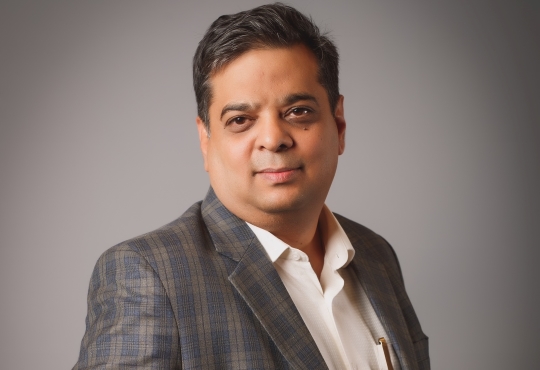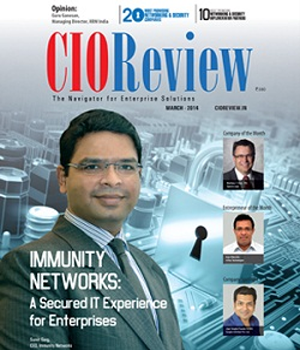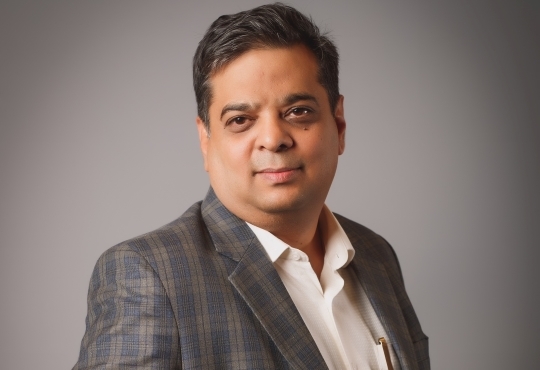
Enhancing Security Posture in Indian Organizations: Practical Solutions
Ajay Gupta, Country Manager - India and SAARC, Netskope
 In a recent conversation with Bimlesh Prasad, a correspondent at CIOTechoutlook magazine, Ajay Gupta, Country Manager - India and SAARC, Netskope shares insights into the evolving security landscape in India, addressing data control, vulnerabilities, cloud adoption, and privacy regulations. Also, he explores strategies to enhance security measures, harness cloud-based solutions, and prepare for future advancements in security technologies within the Indian context.
In a recent conversation with Bimlesh Prasad, a correspondent at CIOTechoutlook magazine, Ajay Gupta, Country Manager - India and SAARC, Netskope shares insights into the evolving security landscape in India, addressing data control, vulnerabilities, cloud adoption, and privacy regulations. Also, he explores strategies to enhance security measures, harness cloud-based solutions, and prepare for future advancements in security technologies within the Indian context.
Ajay Gupta is a seasoned professional with 25 years of expertise in networking and security, with a remarkable 20-year stint in information security. As the Head of Netskope for India and the SAARC territory, he spearheaded the sales team, playing a pivotal role in the company's success. His illustrious journey encompasses diverse roles at renowned organizations like Forcepoint, Ramco Systems. Below are the excerpts from the exclusive interview –
How has the evolution of security practices in India impacted organizations? What are some key challenges they face?
The evolution of security practices in India has a profound impact on organizations, but it also presents several challenges. India's rapid economic growth and digitalization, including a shift to cloud solutions and SaaS applications, mean that data is often beyond an organization's control. This poses challenges related to data leakage, whether intentional or accidental. Additionally, patching all the digital solutions with the latest updates is a time-consuming task. Moreover, the scarcity of skilled security professionals in the market further compounds these challenges. Despite a high demand for cybersecurity experts, finding individuals with the right skills remains a significant obstacle in the Indian market. In summary, while India's digital transformation offers numerous opportunities, it also underscores the critical need for robust cybersecurity practices and addressing the shortage of skilled professionals.
What are the most common vulnerabilities that organizations in India encounter in terms of security? How can these vulnerabilities be addressed?
In India, organizations face a surge in security vulnerabilities, particularly related to rapidly adopted cloud applications. The threat landscape is evolving rapidly, with malware incidence doubling in the past year, now accounting for nearly 63% of detections. Notably, malware is often delivered via trusted cloud applications like Google Gmail, GitHub, and Microsoft SharePoint.
Data from Netskope’s Threat Labs finds that in India, OneDrive stands out as a significant source of malware, contributing to 35% of such attacks, compared to a lower global average. Google Gmail also sees a higher proportion of attacks in India, with 14% compared to the global rate of 2%. In total,more malware is now downloaded via cloud apps than via the web, which makes cloud security a must for understanding the traffic, user activity and taking the desired action.
To combat these vulnerabilities, organizations employ several strategies. They identify and block risky applications that pose data security threats. Sanctioned applications are permitted, while risky ones are restricted based on their threat scores. Additionally, organizations implement Data Loss Prevention (DLP) policies to monitor data flows, detect sensitive information, and prevent data breaches. URL filtering and AI/ML engines are used to block malicious URLs and domains, safeguarding HTTP and HTTPS traffic.
Furthermore, organizations are adopting innovative technologies such as remote browser isolation to enhance URL filtering. This approach offers protection against risky URLs, newly registered domains, and newly categorized websites. These measures are critical in the fight against emerging vulnerabilities and security threats in India's rapidly evolving digital landscape.
How can organizations in India effectively integrate Security Service Edge into their existing security infrastructure to enhance protection against evolving threats?
Indian organizations can effectively integrate Security Service Edge (SSE) into their existing infrastructure to bolster protection against evolving threats. SSE is an emerging approach to network security, encompassing services such as firewall as a service, secure web gateways, IPS, data leakage prevention, and network access control. This approach positions security solutions at the network's exit point, enhancing security posture by reducing latency, improving user experience, and offering centralized visibility and control for administrators.
Many Indian organizations are embracing SSE due to its advantages. It simplifies management with one platform, user interface, and policy application, reducing the need for patching and updates across multiple solutions. Administrative overhead is minimized, and security posture is strengthened.
Several organizations in India, including manufacturing and IT firms, have transitioned to SSE platforms. They typically start with one or more SSE components and expand gradually, eventually consolidating their security measures onto a unified platform. This approach streamlines security operations and provides a comprehensive security solution.
How can organizations in India build resilience and adaptability in their security strategies to effectively respond to the constantly evolving threat landscape?
Organizations can enhance security by prioritizing resilience and adaptability. Key strategies include regular risk assessments to identify vulnerabilities, the development of a comprehensive security framework encompassing people, processes, and technologies, and the creation of detailed incident response plans. Security insurance is essential. Equally important is employee training and awareness, educating them about cybersecurity risks and providing ongoing training. Redirecting users to informative pages when they access risky applications can also help educate employees about potential risks and data sharing precautions. Overall, fostering a culture of cybersecurity awareness and proactive risk management is crucial for organizations in India and beyond.
How can organizations in India leverage cloud-based security solutions to address the challenges associated with securing distributed and remote workforces?
To address cloud-based security challenges and optimize strategies for Indian organizations, several key considerations come into play. Cloud-based solutions offer increased availability and enhanced security, as data is no longer confined within organizational boundaries. However, the distributed nature of cloud data necessitates a proactive approach to ensure robust security and compliance.
- Visibility and Policy Management: Organizations should prioritize gaining visibility into their SaaS applications. With an average of over 1000 applications used within organizations, it's essential to identify sanctioned applications and block or educate users about non-compliant ones. Having clear policies in place based on application visibility is crucial.
- Protecting Sensitive Data: Data leakage prevention must extend beyond traditional channels like web, email, and endpoints to include SaaS applications and Infrastructure as a Service (IaaS). Comprehensive security measures are required to safeguard data across all five channels effectively.
- Advanced Threat Protection: Implementing advanced threat protection measures, including browser isolation technologies, anomaly detection, and anti-phishing solutions, is essential to enhance security and reduce risks, particularly in a cloud environment.
- Zero Trust Network Access (ZTNA): Organizations are increasingly adopting ZTNA to replace traditional VPNs. ZTNA provides a one-directional approach, allowing outbound traffic only. This approach minimizes the risk associated with traditional VPNs, where users gain full network visibility upon connection.
- Access Management and Posture Checks: In the context of cloud adoption, ensuring secure access from corporate, personal, or bring-your-own devices is crucial. Implementing posture checks for personal devices can help enforce different data loss prevention (DLP) policies.
- Compliance and Regulatory Standards: As organizations embrace public cloud and SaaS applications, adherence to regulatory compliance standards such as MIS, PCSS, and others becomes vital. Regularly assessing cloud app configurations against compliance benchmarks helps maintain data security and integrity.
Adopting a holistic approach to cloud security, encompassing technology, policies, and user education, is essential for effectively leveraging the benefits of cloud computing while ensuring data protection and compliance.
What are the future prospects and advancements in security technologies and practices that organizations in India should be prepared for?
As India's organizations embrace digital transformation, advancements in security technologies, such as generative AI, bring both benefits and risks. While Generative AI applications have the potential to improve work efficiency, they also introduce new risks and expose sensitive data to external threats. Organizations need to address these challenges to ensure the confidentiality, integrity, and security of their data.
IoT security gains significance as employees connect various devices to networks, requiring proactive vulnerability management. Upcoming privacy and data protection regulations in India demand stricter controls on personal data sharing. Employee education on security risks is crucial as threat actors exploit these platforms. Indian organizations must balance technological innovation with robust security practices, emphasizing security awareness, compliance with data protection regulations, and addressing IoT security to navigate the evolving security landscape.
CIO Viewpoint
Upcoming Technological Advancements in Payments...
By Pinak Chakraborty, CIO of Airtel Payments Bank
Shaping the Future of AI: Talent, Innovation,...
By Yann LeCun, Chief AI Scientist at Meta
Future of Smart Manufacturing: Integrating Tech...
By Mohammed Kaishulla, Chief information officer, EPACK Durable
CXO Insights
Enhancing Security Posture in Indian...
By Ajay Gupta, Country Manager - India and SAARC, Netskope
7 Types of User Authentication for Stronger...







